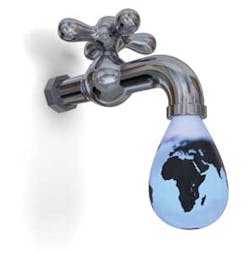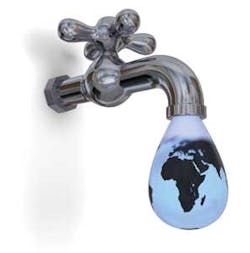By Dawn Kristof Champney
CEOs of major water and wastewater equipment companies convened in Chicago on Tuesday, Sept. 24, at the annual WWEMA Presidents Council event to share perspectives on a vast range of issues concerning them. The exchange of viewpoints was enlightening, and in some instances alarming, as they discussed current market conditions, opportunities for growth and obstacles that could undermine progress for companies serving the water and wastewater industry.
Taking a view of the global market, WWEMA members saw pockets of hope in Panama on the water side and Columbia on the wastewater side. Mexico also received strong marks for growth, as did Vietnam and Singapore, due in large part to oil and gas businesses. While the EU is pushing countries in Eastern Europe to comply with environmental standards, funding there remains problematic. Demand in China continues to grow but at a slower rate, causing a ripple effect on the market in Australia. As host to the World Cup in 2014 and the Olympics in 2016, Brazil should be a hotbed for infrastructure business. But with crime on the rise, tough labor laws, restrictive local content rules, and difficulty in getting money out of the country, Brazil presents many challenges for foreign suppliers.
Domestically, the United States is showing signs of economic improvement, especially in the housing market, which is resulting in a pickup of activity on the municipal front. Design work is on the rise, though much of it is focused on the distribution and collection side. The spare parts business is strong, as is demand for energy-efficiency and water conservation products.
Municipalities are evaluating their assets to determine how best to invest their limited financial resources, especially in light of decreases in income attributable to increased water conservation efforts. Access to affordable capital continues to pose a challenge for communities, with states withholding assistance from their state revolving funds in response to the cutback in federal contributions. It was noted that EPA is applying pressure on certain states to release their funds or risk having them rescinded.
With the exception of a few limited consent decrees focused on curbing combined sewer overflows, there appears to be a waning of enforcement activities, which oftentimes dictate capital investment spending. In place of a strict enforcement regime, regulators are now working with communities to develop integrated plans, prioritizing which projects to undertake first so as to address their most serious wastewater and stormwater challenges. This is being viewed as good for business, as it offers communities the flexibility to meet their environmental obligations in a cost-effective and sustainable manner without fear of enforcement action.
On the industrial side, fracking has spawned the creation of a number of service companies but has not significantly impacted demand for treatment technologies, though there exists opportunities for innovation in that space. Water conservation and water reuse in industrial applications offer the greatest opportunity for water and wastewater equipment suppliers. This may prove especially true for steam electric power plants that may be forced to switch to zero-liquid discharge in order to comply with revised effluent guidelines recently proposed by EPA. That rule also contains extremely stringent nitrate requirements, with a price tag ranging from $1.45 billion to $6.24 billion in capital investment, depending on which regulatory option is ultimately selected.
Among the issues causing consternation among the CEOs at this year's Presidents Council event are the increased cost to comply with the Affordable Health Care Act; the difficulty of finding skilled workers and obtaining H1B visas; the challenge of obtaining and defending patents; and the longer lead times to secure raw materials, especially for nickel, stainless steel and carbon.
The general sense of the market outlook remains cautiously optimistic, with 2014 starting off slow but growing steadily in the last quarter and into 2015. Let us hope that rumors of another recession in 2019 prove to be highly exaggerated.
About the Author: Dawn Kristof Champney is president of the Water and Wastewater Equipment Manufacturers Association, a non-profit trade organization founded in 1908 to represent the interests of companies that manufacture products sold to the potable water and wastewater treatment industry. Its mission is to inform, educate and provide leadership on issues that affect the worldwide water and wastewater equipment industry.



